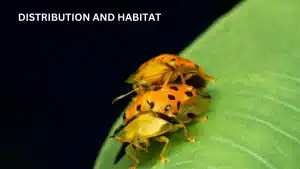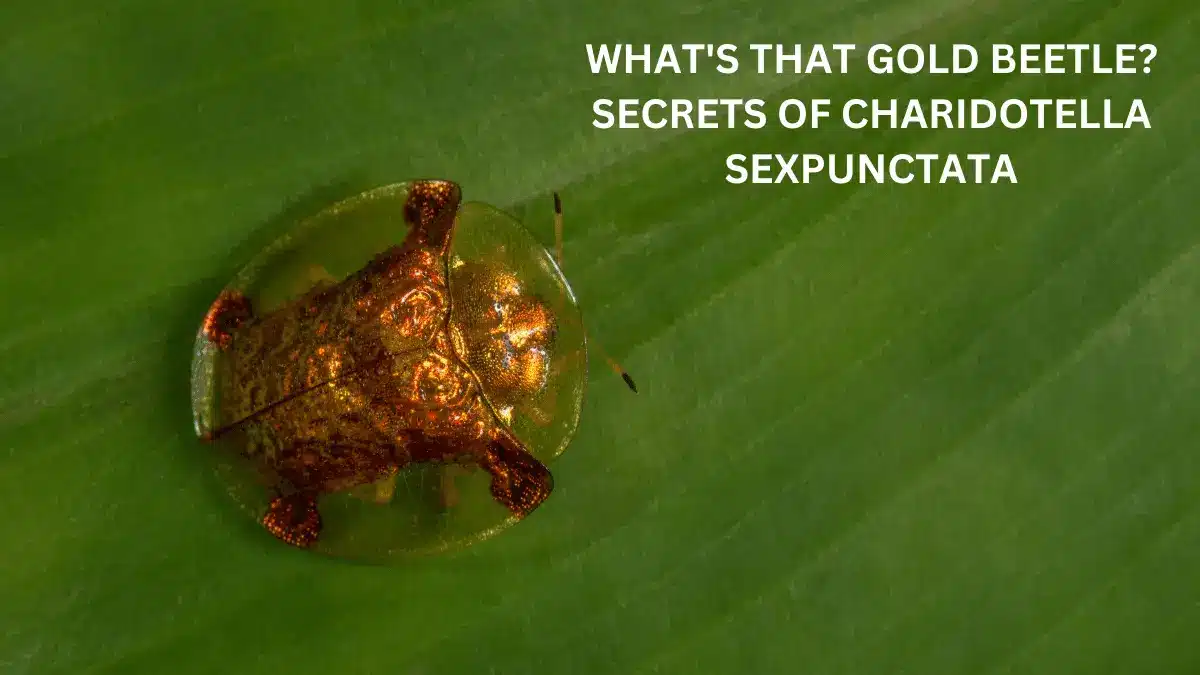The interesting North American golden tortoise gold beetle (Charidotella sexpunctata) is native.
This insect stands out against plant leaves and stems due to its striking metallic gold hue. This leaf beetle is notable for its brilliant golden hue, which ranges from pale yellow to bright metallic gold.
The golden tortoise beetle can turn red or orange when threatened or agitated. This modification gives it concealment and blends in.
Beetles like this eat a range of plants, including morning glory. Their unique mouthparts let them digest plant material.
These beetles are protected from predators by their tortoise-shell-shaped domes.
The golden tortoise beetle’s biology and ecology reveal insects’ extraordinary adaptations and reproduction tactics.
Table of Contents
Let’s delve into the beauty of the gold beetle!
All About Charidotella Sexpunctata
The Twice-stabbed Lady Beetle, or Charidotella sexpunctata, is a species of lady beetle that is a member of the Coccinellidae family.
The entire continent of North America, including Canada, is home to this little insect.
Due to two red marks that resemble stab wounds on its back, the “Twice-stabbed Lady Beetle” is so named.
Oval in shape, adult beetles can range in color from yellow-orange to crimson. Behind their heads, they have a striking black marking that resembles a pair of curving horns.
Because it feeds on aphids, mites, and other microscopic insects that are considered pests in farming and gardening, Charidotella sexpunctata is a helpful insect.
These lady beetles have a tremendous egg-laying capacity, and they use a sticky adhesive to attach the eggs to plants.
The eggs hatch into larvae, which are also helpful predators, and they go through many developmental stages before becoming adults.
In biological control programs used in agricultural and horticultural settings, Charidotella sexpunctata is an essential natural opponent of pests.
Physical Characteristics Of Golden Tortoise Beetle
The golden beetle is a member of the leaf beetle family Chrysomelidae. It earns its common name from its distinct golden coloration on the elytra (hardened forewings).
The elytra have a transparent margin that reveals the beetle’s brownish-red wings underneath.
Another key identifier is the presence of six black spots on the elytra, three per side.
Adult golden tortoise beetles reach 5 to 7 mm in length.
Their oval-shaped bodies are convex and compact. The head is tucked underneath the pronotum (section behind the head).
Golden tortoise beetle larvae are spiny and darkened in color, lacking the metallic appearance.
Distribution And Habitat

The golden tortoise beetle is widely distributed across the eastern and central United States and southeastern Canada.
Its habitat consists of areas where its host plants grow, including bindweeds, morning glories, sweet potatoes, and other convolvulaceous plants.
These plants contain toxins that the beetle can sequester for its defense.
Golden tortoise beetles are commonly found in fields, gardens, and disturbed areas. They prefer warmer environments and are active from spring through fall.
During colder months, they overwinter as adults in protected sites like leaf litter or under bark.
Feeding And Behavior
Both adult and larval golden tortoise beetles are foliage feeders.
They use their mouthparts to create holes and pits in the leaves of host plants, sometimes skeletonizing the foliage.
Heavy infestations can stress and even kill plants if left uncontrolled.
One of the golden tortoise beetle’s most fascinating defenses is its ability to manipulate its outer shell.
Using specialized muscles, the beetle can snap its elytra (wing covers) up and over its body and legs, taking on the appearance of a small tortoise shell.
This helps camouflage it against predators when disturbed. Tortoise beetles can also secrete irritating chemicals as further protection.
Life Cycle

Golden tortoise beetles undergo complete metamorphosis with four life stages:
Egg – Females lay clusters of tiny yellow eggs on the undersides of leaves. Each female produces 40-60 eggs.
Larva – The larvae hatch in 4-15 days. Larvae are spiny and darkened in color, unlike the golden adults. They pass through three instars while feeding on leaves.
Pupa – In the final larval stage, the insect attaches itself to a leaf and molts into a pupa. This non-feeding stage lasts 7-13 days.
Adult – Adult golden tortoise beetles emerge from pupae and reach maturity after feeding for a short time. Adults live for around 30-60 days.
The complete life cycle takes 30-45 days in optimal summer conditions. There are 1-2 generations per year in northern areas and up to five generations in southern states.
Gardening And Pest Control
For gardeners, small populations of golden tortoise beetles are generally not cause for concern.
They help decompose plant matter and serve as prey for beneficial insects like lady beetles.
But larger infestations can quickly defoliate host plants, requiring control measures.
One organic approach is to simply hand-pick the insects from plants and drop them in soapy water.
Ensure you remove all life stages, including eggs and larvae. Row covers can exclude beetles from plants early in the season.
Natural insecticides based on neem oil or spinosad can also help manage populations.
Video Of Charidotella Sexpuntata Golden Tortoise Beetle
Conclusion
In conclusion, the secrets revealed about Charidotella sexpunctata, also known as the golden tortoise beetle, shed light on its fascinating characteristics.
First, it was discovered that this beetle possesses a unique ability to rapidly change its vibrant golden color into an opaque brown hue as a defense mechanism against predators.
This color change is driven by the movement of liquid within its cuticle, making it a remarkable example of adaptive camouflage in the animal kingdom.
Additionally, research revealed that the golden tortoise beetle has evolved specialized structures on its body that enable it to remain firmly attached to its food source, making it a highly efficient herbivore.
It is also intriguing to note that this beetle exhibits sexual dimorphism, with males and females differing in their color patterns and overall size.
Overall, the secrets revealed about the golden tortoise beetle highlight its importance in ecological systems, as well as its extraordinary adaptations for survival and reproduction.
I hope you like it!
FAQ.s
Are gold beetles made of gold?
No, Gold Beetles are not made of gold. Their metallic appearance is a result of structural coloration in their exoskeleton.
Can the gold beetle’s color be replicated for human use?
Scientists are studying the Gold Beetle’s structural coloration to develop innovative technologies for applications like cosmetics and textiles.
Do gold beetles have any predators?
Yes, Gold Beetles have predators like birds and other insects. Their adaptability and survival strategies help them evade these threats.
Are gold beetles endangered?
While some species may be threatened due to habitat loss, many Gold Beetle varieties are thriving in their respective ecosystems.
How do gold beetles contribute to their ecosystems?
Gold Beetles play essential roles as pollinators and decomposers, aiding in nutrient cycling and maintaining ecological balance.
Related Articles
What Is A Soldier Beetle? Tiny Nature-Friendly Pollinators
What are Dermestid Beetles, is it a cleanup crew for nature?
Must Know About The Mealworm Beetle: Top Facts And Life Cycle
Discover The Threat: Cigarette Beetles And Drugstore Beetles Explained
